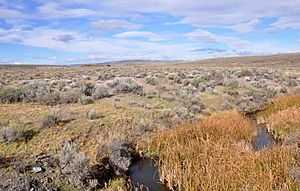Crooked Creek (Oregon) facts for kids
Quick facts for kids Crooked Creek |
|
|---|---|

Crooked Creek south of Burns Junction
|
|
|
Location of the mouth of Crooked Creek in Oregon
|
|
| Country | United States |
| State | Oregon |
| County | Malheur |
| Physical characteristics | |
| Main source | Crooked Creek Springs Malheur County 3,921 ft (1,195 m) 42°40′32″N 117°54′33″W / 42.67556°N 117.90917°W |
| River mouth | Owyhee River 4.5 miles (7.2 km) northwest of Rome 3,343 ft (1,019 m) 42°52′57″N 117°41′52″W / 42.88250°N 117.69778°W |
| Length | 51 mi (82 km) |
| Basin features | |
| Basin size | 1,340 sq mi (3,500 km2) |
Crooked Creek is a river in Oregon, a state in the United States. It flows for about 51 miles (82 kilometers). Crooked Creek is a tributary of the Owyhee River. This means it's a smaller stream or river that flows into a larger one.
Contents
Exploring Crooked Creek
Crooked Creek is an important natural feature in Malheur County, Oregon. It helps shape the land and provides water for the area. Rivers like Crooked Creek are vital for plants, animals, and even people.
Where Does Crooked Creek Start and End?
Every river has a beginning, called its source, and an end, called its mouth. Crooked Creek starts high up at Crooked Creek Springs. This spot is about 3,921 feet (1,195 meters) above sea level.
The creek then flows downhill, eventually reaching its mouth. It joins the Owyhee River near a town called Rome. At this point, the elevation is about 3,343 feet (1,019 meters).

What is a Watershed?
Crooked Creek has a very large watershed that covers about 1,340 square miles (3,471 square kilometers). A watershed is like a giant bowl. It's an area of land where all the rain and snowmelt drain into a single river, lake, or ocean.
Imagine all the water that falls on this huge area. It all flows downhill, eventually making its way into Crooked Creek. This water then continues its journey into the Owyhee River.
Why Are Rivers Important?
Rivers like Crooked Creek are super important for many reasons:
- Water Supply: They provide fresh water for drinking, farming, and industries.
- Habitats: They are home to many different kinds of fish, insects, and other wildlife.
- Transportation: Historically, rivers were used for travel and moving goods.
- Recreation: People enjoy rivers for activities like fishing, boating, and swimming.
- Shaping the Land: Over long periods, rivers carve out valleys and canyons, changing the landscape.
Crooked Creek, though not as famous as some larger rivers, plays its part in the natural world of Oregon. It's a great example of how even smaller waterways contribute to the health of our planet.


